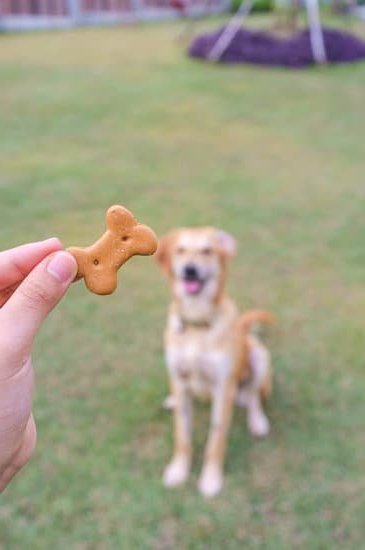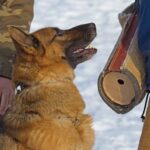How do you train a dog to shake hands? Teaching your dog to perform this adorable trick not only adds an impressive skill to their repertoire but also comes with a range of benefits. From strengthening the bond between you and your furry friend to providing mental stimulation and enhancing obedience, teaching your dog to shake hands can be a rewarding experience for both of you.
In order to effectively train your dog to shake hands, it is important to understand the basics of dog training and the significance of positive reinforcement. This form of training focuses on rewarding desired behaviors, such as shaking hands, with treats and praise, rather than punishing undesired behaviors. By utilizing positive reinforcement, you can create a positive learning environment for your dog, making the training process enjoyable and effective.
Before embarking on the journey of teaching your dog to shake hands, it is essential to gather the necessary tools and treats. Having high-value rewards such as small pieces of chicken or cheese will motivate your dog during training sessions. Additionally, having a clicker or using verbal markers can help communicate with your dog more clearly during the training process. With these foundations in place, you are ready to start teaching your dog this fun and charming trick.
Understanding the Basics of Dog Training
When it comes to training your dog, it’s important to understand the role that positive reinforcement plays in shaping their behavior. Positive reinforcement involves rewarding your dog for exhibiting the desired behavior, which encourages them to repeat that behavior in the future. This type of training is not only effective but also helps build a strong and trusting bond between you and your furry friend.
The Science Behind Positive Reinforcement
Positive reinforcement works by associating a reward with a specific behavior, such as giving your dog a treat when they successfully shake hands. This creates a positive association in your dog’s mind, making them more likely to offer the same behavior in exchange for a reward. It’s important to note that the timing of the reward is crucial – it should be given immediately after the desired behavior occurs to reinforce the connection between the action and the reward.
The Role of Consistency
Consistency is key when it comes to positive reinforcement training. In order for your dog to learn and understand what is expected of them, it’s important to consistently reward the desired behavior every time it occurs. Additionally, everyone in the household should use the same commands and rewards to avoid confusion for your furry companion.
Choosing the Right Rewards
When using positive reinforcement to train your dog to shake hands, it’s important to choose rewards that are highly motivating for them. Whether it’s their favorite treats, toys, or praise, find what motivates your dog and use that as a reward during training sessions. By using rewards that hold value for your pet, you are more likely to see successful results in their training progress.
Preparing for Training
Before you begin training your dog to shake hands, it’s important to gather the necessary tools and treats to make the process as smooth and effective as possible. Here are some essential items you’ll need:
1. Treats: Choose small, soft, and tasty treats that your dog loves. These will serve as a reward for your dog’s good behavior during training. Make sure to have a good supply of treats on hand, as you’ll be using them frequently throughout the process.
2. Clicker (optional): A clicker can be a helpful tool for marking the exact moment when your dog performs the desired behavior. This clear signal can help communicate to your dog which actions are being rewarded.
3. Patience and positive attitude: While not physical tools, these are essential components for successful training. Keep in mind that training takes time and consistency, so approach each session with patience and a positive attitude.
Once you have gathered these tools, find a quiet and distraction-free environment where you can work with your dog without interruptions. This will help create an optimal learning environment for both you and your furry friend.
By preparing these necessary items and setting up the right training environment, you’ll be equipped to effectively teach your dog to shake hands in a positive and rewarding way.
Remember that building trust between you and your pet is crucial in successful training sessions, since it promotes respect and understanding from both ends – leading to a more pleasant experience for all involved parties.
Step-by-Step Guide to Teaching Your Dog to Shake Hands
Training your dog to shake hands can be a fun and rewarding experience for both you and your furry friend. The shake hands command is not only a cute trick, but it also helps to strengthen the bond between you and your dog. In this step-by-step guide, we will go through the process of teaching your dog to shake hands, starting from the basic commands all the way to hand signals.
The key to successful dog training is positive reinforcement. This means that you will reward your dog for exhibiting the desired behavior, in this case, shaking hands. Rewards can come in the form of treats, praise, or playtime. It’s important to be patient and consistent throughout the training process, as every dog learns at their own pace.
To begin training your dog to shake hands, you will need a few essential tools and treats. A clicker (if you choose to use one), some small and tasty treats that your dog loves, a quiet training area free from distractions, and lots of patience are all necessary for successful training sessions. With these tools in hand, you’ll be ready to start teaching your dog how to shake hands using positive reinforcement techniques.
The step-by-step process of teaching your dog to shake hands involves breaking down the behavior into smaller tasks and gradually building up to the final trick. It’s important to start with basic commands such as “sit” or “stay” before introducing the handshake command. Using hand signals alongside verbal cues can also help reinforce the behavior effectively. Remember that consistency and regular practice are key in successfully teaching your dog how to perform this adorable trick.
| Key Points | Details |
|---|---|
| Positive Reinforcement | Rewarding your dog for exhibiting the desired behavior is crucial for successful training. |
| Necessary Tools | A clicker (optional), small treats, quiet training area are essential for effective training sessions. |
| Step-by-Step Process | Breaking down the behavior into smaller tasks and using verbal cues alongside hand signals can help teach your dog how to shake hands. |
Troubleshooting Common Challenges
When it comes to training your dog to shake hands, you may encounter some common challenges along the way. Dealing with stubborn behavior and distractions can be frustrating, but with patience and the right approach, you can overcome these obstacles.
One common challenge when teaching a dog to shake hands is stubborn behavior. Some dogs may be resistant to learning new commands, and it’s important to understand that every dog learns at their own pace. Using positive reinforcement techniques such as praise and treats can help encourage your dog to keep trying. It’s also crucial to be patient and consistent in your training efforts, as rushing or becoming frustrated can actually hinder your progress.
In addition to stubborn behavior, distractions can also pose a challenge when training your dog to shake hands. Whether it’s other animals, noises, or simply the excitement of being outdoors, distractions can make it difficult for your dog to focus on the task at hand.
One effective way to address this is by gradually introducing distractions into your training sessions. Start in a quiet environment and gradually work up to more distracting situations, always rewarding your dog for maintaining focus despite the added stimuli.
| Common Challenges | Dealing With Stubborn Behavior and Distractions |
|---|---|
| Stubborn behavior | Using positive reinforcement techniques such as praise and treats |
| Distractions | Gradually introducing distractions into training sessions |
Maintaining and Reinforcing the Behavior
Once you’ve successfully trained your dog to shake hands, the work doesn’t stop there. It’s important to consistently reinforce and maintain this behavior to ensure that your furry friend continues to perform the trick on command. Consistency is key when it comes to dog training, and practicing regularly will help solidify the behavior in your dog’s mind.
Consistency Is Key
Consistency in training means using the same commands, hand signals, and rewards each time you practice with your dog. If you start using different cues or rewards, it can confuse your pet and make it harder for them to understand what is expected of them. Make sure that all family members and anyone else interacting with your dog are also consistent in reinforcing the behavior to avoid any confusion.
Practice Makes Perfect
Repetition is crucial when it comes to reinforcing the behavior of shaking hands. Spend a few minutes each day practicing the command with your dog. This can be integrated into their daily routine as a fun way to bond with your pet. The more you practice with your dog, the more reliable their response will become.
Using Positive Reinforcement
Continue to use positive reinforcement such as treats, praise, and affection when your dog successfully shakes hands. This will motivate them to continue performing the trick and associate it with positive experiences. Consistently praising and rewarding your dog for their good behavior will strengthen their understanding of the command and encourage them to keep doing it.
By maintaining consistency and practicing regularly, you’ll ensure that your dog continues to shake hands on command. Additionally, using positive reinforcement will create a strong bond between you and your furry companion, making training an enjoyable experience for both of you.
Going Beyond the Basics
Teaching your dog to shake hands can be the foundation for more advanced tricks and commands. Once your dog has mastered the basic handshake, you can use this skill as a building block for teaching them even more impressive tricks. Here are some fun and advanced tricks you can teach your dog using the shake hands command:
- High Five: Once your dog has mastered shaking hands, you can elevate the trick to a high five. You can achieve this by holding your hand higher and encouraging your dog to reach up and touch it with their paw.
- Wave: Teach your dog to wave by using a hand signal instead of asking for a physical touch. This could involve waving your own hand and prompting your dog to mimic the action with their paw.
- Rollover: While not directly related to shaking hands, you can incorporate the handshake into teaching your dog to rollover. Start by giving the shake command, then guide them into a lying down position and reward them once they complete the full rollover motion.
It’s important to remember that patience and consistency are key when teaching advanced tricks. Using positive reinforcement techniques, such as treats and praise, will help motivate your dog to learn these new commands. By building on the foundation of basic training, you can continue to strengthen the bond between you and your furry friend while also impressing friends and family with their newfound talents.
In addition to impressing others, these advanced tricks serve as mental stimulation for your dog, keeping their mind engaged and active. It’s a fun way to provide enrichment for them while deepening the trust between you as they respond eagerly to learning new things. Keep in mind that every dog is different, so it’s important to tailor your training approach based on their individual personality and learning style.
The Impact of Training on the Bond Between You and Your Dog
In conclusion, training your dog to shake hands is not only a fun and impressive trick, but it also has a significant impact on the bond between you and your furry friend. By understanding the basics of dog training and using positive reinforcement, you can create a strong foundation for teaching your dog new commands. It is important to gather the necessary tools and treats before starting the training process, as well as being patient and consistent throughout the process.
As you go through the step-by-step guide to teaching your dog to shake hands, it is essential to remain patient and persistent, especially when facing common challenges such as stubborn behavior and distractions. By maintaining and reinforcing the behavior with consistency and practice, you are not only teaching your dog a new trick but also building trust and strengthening your relationship.
This training goes beyond just teaching tricks; it is about communication, understanding, and mutual respect between you and your canine companion.
Moreover, training your dog to perform tricks using the shake hands command can further enhance the bond between you two. The time spent together during training sessions creates opportunities for bonding and improves communication. As a result of this active engagement with your pet, both of you will feel more connected, leading to a stronger relationship built on trust and understanding. Therefore, consistently practicing positive reinforcement-based techniques can help deepen the connection between you and your four-legged friend.
Frequently Asked Questions
Why Won’t My Dog Shake My Hand?
There could be several reasons why your dog won’t shake your hand. It’s possible that they were never taught the behavior, or they are not motivated to do it. It could also be due to fear or discomfort.
How Might You Use Shaping to Teach a Dog to Shake Hands?
Shaping can be a effective way to teach a dog to shake hands. It involves rewarding the dog for making small, progressive movements towards the desired behavior. For example, you can reward the dog for lifting their paw off the ground, then for extending it towards your hand.
How Do You Teach a Dog to Shake on Command?
Teaching a dog to shake on command involves capturing and shaping the behavior. You can start by saying “shake” as the dog naturally lifts its paw (capturing), and then reward them. Gradually, you can use shaping techniques to refine the behavior and reinforce it with positive reinforcement.

Welcome to the blog! I am a professional dog trainer and have been working with dogs for many years. In this blog, I will be discussing various topics related to dog training, including tips, tricks, and advice. I hope you find this information helpful and informative. Thanks for reading!





